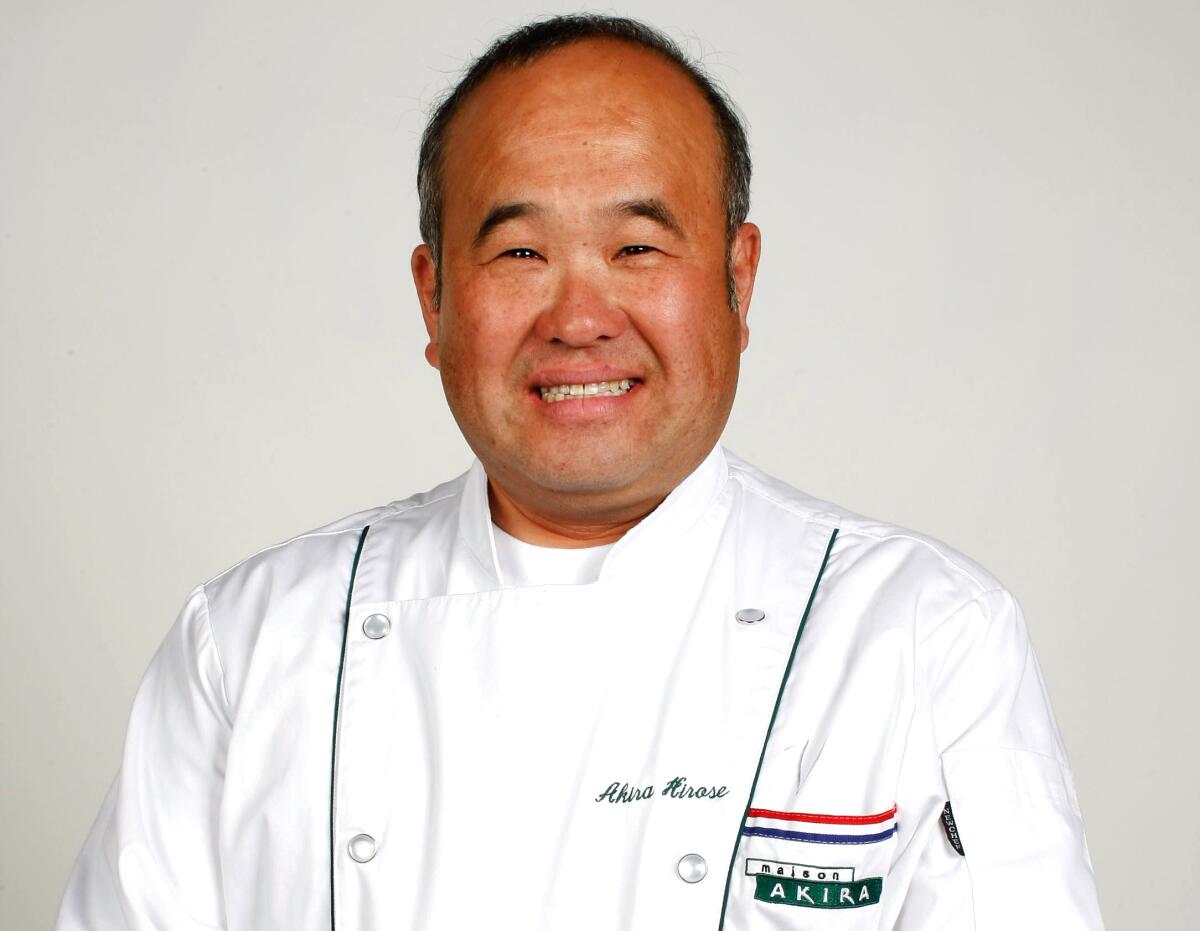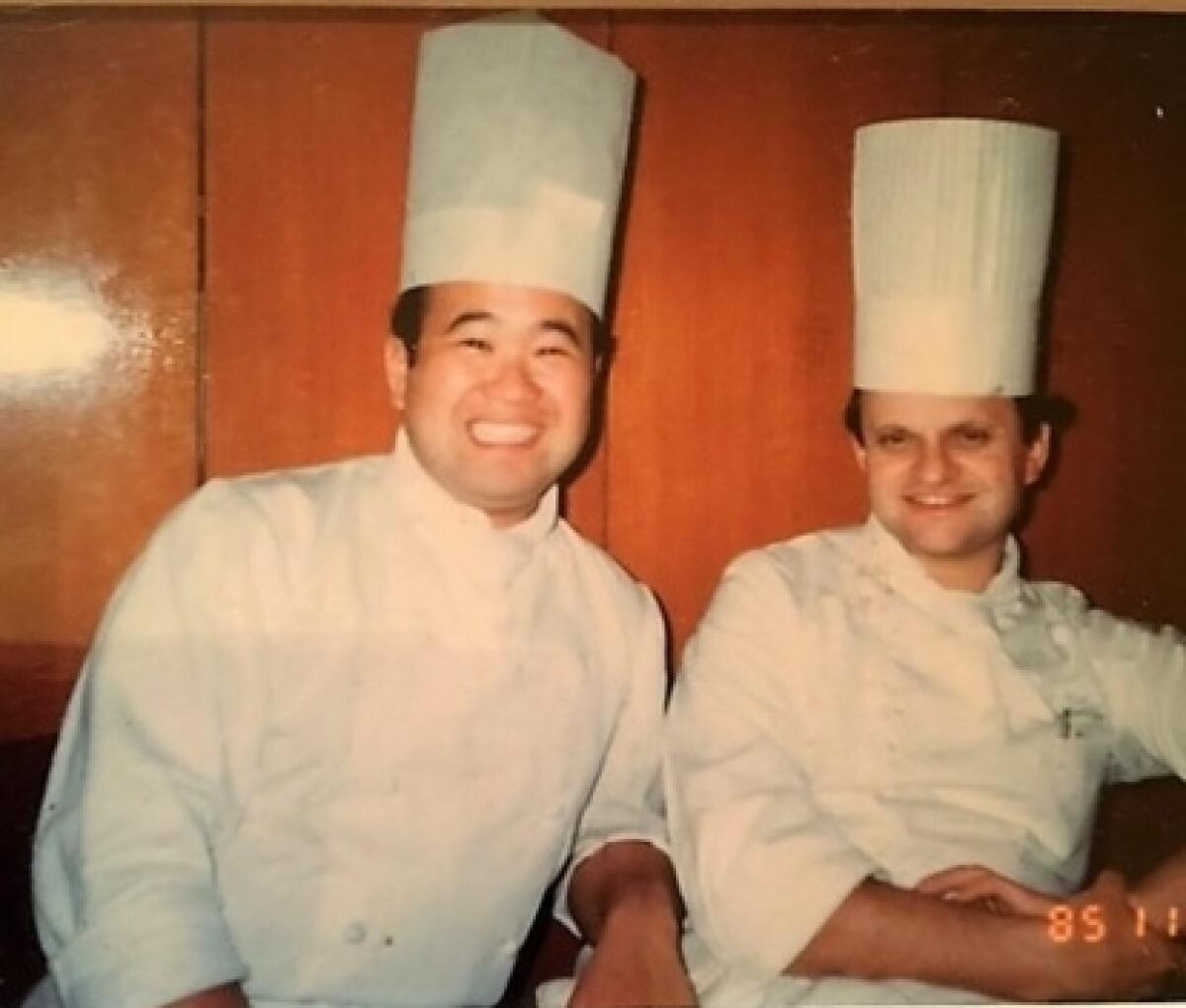Genre-bending Japanese-French chef Akira Hirose dies at 70

- Share via
- Chef Akira Hirose helped popularize Asian flavors through fusion cuisine in 1980s and ’90s Los Angeles.
- His career spanned decades and continents, where he worked with some of the world’s most famous French chefs.
- His casual neighborhood restaurant, Azay, still focuses on supporting the Little Tokyo community.
Akira Hirose, a chef who bridged Japanese and French cuisine for decades across some of L.A.’s most influential restaurants, has died at 70.
The legacy of the former Azay and Maison Akira owner, who died Sept. 26, continues to reverberate; the Japanese-born, French-trained chef who cooked with Joël Robuchon and for the emperor and empress of Japan helped popularize Asian flavors through the lens of French technique.
“Having one foot in Japan, one foot in France and one foot here — straddling that line — he wasn’t a Japanese man, he wasn’t a French man, he wasn’t American,” said his son, Azay owner Philip Hirose. “He wasn’t any of that, but he was all of it combined.”
Despite a recent liver transplant, failing eyesight and a general slowing of pace, he could be found by family, staff and fans in the kitchen of Azay, his Little Tokyo cafe, seven days a week — even if just prepping for service by cooking rice or batches of miso soup. He still wanted to be involved, he still wanted to support his staff.
The convivial chef who never used measuring tools followed a clear ethos in his restaurants and his personal life: Be happy, work hard, work together. His presence is still felt throughout the restaurant: Framed photos in the dining room chart the course of his culinary career through France, Tokyo and Los Angeles. French cookbooks from famous chefs — many autographed — line the shelf.

“For him, it was just about simple food and good people,” Philip said. “He had a lot of knowledge just with his hands. He had those burn marks. He was that old-school chef that is so rare nowadays.”
Akira Hirose was born in Kyoto in 1954, the third son of four, which allowed him to pursue a trade beyond the family business of accounting. He spent his adolescence helping his family, but a meal in a French restaurant in Kyoto changed the trajectory of his life. He became fascinated by French cuisine and wanted to dedicate his time to it, and at 18, he moved to France to study it.
As he worked his way through small towns and villages, he learned fine and rustic French cooking, and prepared Japanese food only for staff meals — which his colleagues ate with gratitude in the kitchens of Azay-le-Rideau in the Loire Valley and Le Grand Monarque. He went fox hunting, played the French horn and spent summers swimming in rivers, and cooked traditional French cuisine in the evenings.

At age 24, he moved to Paris, where he spent two years working in Maxim’s de Paris and directly with Joël Robuchon at the Nikko hotel. He studied pastry at Lenôtre. Soon enough, Hirose was asked to join the kitchen at the groundbreaking Los Angeles French restaurant L’Orangerie, where chefs such as Ludo Lefebvre trained before also imprinting on the L.A. dining scene for years to come. It was Hirose’s introduction to life in L.A., and to the woman he would marry.
Hirose had placed an ad for part-time kitchen help in a local Japanese-language newspaper, and Jo Ann Maehara answered. Over shared time in the kitchen, their relationship blossomed. As did Hirose’s culinary career. He later served as the opening chef of the Belvedere at the Peninsula Beverly Hills, where he introduced Japanese flavor into brasserie cooking with splashes of soy and wasabi-tinged mashed potatoes — an early adopter of Asian-fusion cooking.
But Hirose yearned to open his own restaurant, and he moved to Japan to do so with his wife. They opened Azay-le-Rideau in Kyoto under one condition: that they would return to Los Angeles when it was time to start their family.
When they did, he cooked at the Tower restaurant, where white linens draped across tables, cloth napkins fanned out of the glasses and he donned a white chef’s coat. Hirose always felt comfortable in this setting, and while he served a more casual menu at the cafe in Little Tokyo’s Japanese American National Museum, when he debuted his cherished Maison Akira in Pasadena around the same time, in 1998, he ensured some of those hallmarks were present.

Former L.A. Times restaurant critic S. Irene Virbila called the food “unabashedly Franco-Japanese in style” and noted dishes such as foie gras flan, sansho-crusted salmon and, of course, Hirose’s specialty of miso-marinated Chilean sea bass.
By the time the Hiroses closed Maison Akira in 2019, the culinary world had changed drastically.
“It was in an era in which fusion was not a sexy word, and it was not a sexy concept either,” Philip said. “People saw it as shortcuts, they saw it as lazy ... when in reality, we are a fusion of different cultures, of our parents and diaspora.”
When the chef at Grill Lyon in Pasadena decided to go back to Japan, another Japanese-born chef was ready to move right in.
The 75-seat space was losing money. Hirose wanted to provide quality experiences for regulars and stability for his staff; the money and acclaim, Philip said, was less important.
The family opted to open a small cafe in Little Tokyo in the former home of a hardware store that Jo Ann’s family had operated for decades; Philip and Jo Ann plan to reopen the influential Anzen Hardware, founded by Philip’s grandfather, in a new location within the next year or two and a renewed focus on imported Japanese culinary tools.
Azay, a collaborative family effort, would introduce some of Hirose’s French cooking to the neighborhood, paired with more casual Japanese cuisine.
Bill Addison considers morning meals at Azay, Fukagawa, Konbi and Gatsu Gatsu
Under Akira, Azay served delicately plated salads in tarragon vinaigrette, potato galettes, beef Bourguignon served with pasta, classic soufflés, roasted quail and bûche de Noël in addition to donburi, daily bento and Japanese breakfast.
During the COVID-19 pandemic, the family pivoted to takeout and produce boxes. Philip helped introduce his father to community organizing, often using the space to fundraise and cook for community meetings and protests, among other things. Hirose taught his son about restaurant life, and Philip exposed him to mutual aid and food as a political and community tool.

Two years ago, Philip quit his job in film production to join the family business full time after years of supporting Azay remotely and working there on weekends. He’d primarily spent his film career coordinating creatives on shoots; why not do the same in his father’s business instead?
“I think the care for my team was something that my dad passed on to me,” he said. “To him, the staff was his family. He spent so much time with them.”
Philip heads up the restaurant’s wine program, with a focus on central France, in a nod to his father’s culinary origins, and he’s now shepherding a small crew of chefs who will see Azay continue in honor of Akira Hirose.
In August, former Hansei, Eleven Madison Park and Citrin chef Chris Ono joined the team at Azay, taking over dinner service and giving Hirose evenings off. The attempt was twofold: to learn from the chef, and to build a more sustainable business model for Akira, who was still working at the restaurant seven days a week as he aged.

“I loved hearing the stories of all these legendary chefs, and for me, it connected us, and it really gave me insight into the past,” Ono told The Times. “Food and cuisine is a beautiful thing. Knowing its history gives you a full appreciation for this. He was a mentor and friend to me and always supported me in the few years I have known him. He gave me a platform and accepted me into Azay, and I will be forever grateful for this.”
With the aid of chefs Gary Matsumoto, Jared Mori and Ryan Saeki, who all help operate the kitchen, Ono recently reimagined Azay’s evening menu with a weekend prix fixe that still encompasses Japanese and French cuisine. On Saturday, Ono added one of Hirose’s signature dishes to the menu: miso-marinated, locally caught Chilean sea bass over ratatouille and dandelion greens, served with Ono’s flourish of a beurre blanc-like sauce.
Other dishes and favorite ingredients of his father, Philip said, will most likely make their way to Azay’s menu too: rack of lamb, tarragon dressing, leeks, quail.

In the coming months, the team plans to host tribute dinners in honor of Hirose, serving not only his signatures but also inviting some of the chefs who cooked with him in France, L.A. and Japan.
Even before his father’s death, Philip devoted time to learning about Akira. His own interest in wine has led him through many of the French villages and towns where his father lived and cooked decades ago. Philip stops to taste wine with local vintners and crashes on Akira’s friends’ couches, hearing stories and finding faded photos.
On one trip, he learned that his father’s French friends had nicknamed him “the rose of the Touraine” — a nod to both the Hirose surname and a playful riff on how his face would blush when drinking alcohol.
“I got to learn about him through the lens of other people, and when I went there, I got to meet a lot of people for the first time, and they told me that I looked just like him when he was younger,” Philip said. “Even now, as we share the news with them, they say they felt like he had a place in central France as the Japanese man that really became one of them. They saw him as one of their own.”
A memorial service for Hirose will be held Oct. 13 at the Los Angeles Hompa Hongwanji Buddhist Temple in Little Tokyo. Attending chefs are encouraged to don their chefs’ whites in his honor.
More to Read
Eat your way across L.A.
Get our weekly Tasting Notes newsletter for reviews, news and more.
You may occasionally receive promotional content from the Los Angeles Times.












